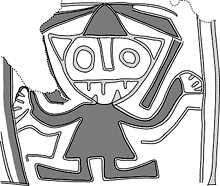April 17, 2003
Religion in the Americas began 2250 BC

Religion in the Americas began 2250 BC

Ancient icon found in Peru is 1,000 years older than any other religious artifact in the region.
By Peter N. Spotts | Staff writer of The Christian Science Monitor
Archaeologists combing rubble in an arid river valley that spills out onto
the central coast of Peru have uncovered a 4,000-year-old gourd
fragment that may represent the oldest religious object ever found in the
Western Hemisphere.
It bears an etched or burned image of what has come to be known as the
"staff god" - a deity whose squat, half-human, half-animal visage
adorns urns and temple walls from Andean cultures spanning thousands of
years.
The find "pushes back the emergence of the oldest known Andean religion
by more than 1,000 years," says Winifred Creamer, an
anthropologist at Northern Illinois University and a member of the team
that discovered the object.
The region's myths assign the staff god the role of creator. Yet the find
also may help tell a larger story, archaeologists say - one that
points to the Norte Chico region as the cradle of Andean civilizations
that culminated in the Inca empire. At their height in the early 1500s,
Incas ruled the largest empire on Earth.
By contrast, during the third millennium BC "you have small hunter-gatherer
bands and fishing villages" throughout today's Peru, says
Jonathan Haas, curator of North American anthropology at the Field Museum
in Chicago and a member of the research team. "Then you
find this giant monster in Norte Chico - cities with large circular plazas,
monumental architecture, and now a divinity figure. That's
extraordinary."
In the figure he calls "our little man," Dr. Haas says "you're seeing mythology,
archaeology, and iconography coming together to open a
window on the emergence of religion, which goes hand in hand with the emergence
of centralized societies."
The researchers discovered the fragment last July when they were sorting
through a looted burial site in the Pativilca River Valley. If the
fragment had been clay, the condition of the site would have made it difficult
to associate the fragment with a particular time. But the teams'
fragment came from a plant, in this case a softball-sized gourd, so it
provided its own time reference for radiocarbon dating. The fragment,
one of two decorated gourd fragments the team found, dated to 2,250 BC
The team, which includes Alvaro Ruiz, codirector of the Norte
Chico Archaeology Project, reported its find in a brief notice in the current
issue of Archaeology magazine, which hit the streets this week.
The staff-god image is a "motif with a long and broad history throughout
several Andean cultures," says Dr. Ruiz. Typically, the deity is
shown face-on, with fangs in its mouth and clawed feet. Snakes often appear
as part of the deity's headgear or clothes. "Most commonly,
the deity is depicted holding a staff in one or both hands, hence its name."
Last year's find has proved to be an auspicious kick-off for the 12-year
project, which aims to explore the Norte Chico region as thoroughly
as possible. Although archaeologists have known about the region for roughly
a century, it didn't draw persistent attention until the mid-90s,
when Peruvian archaeologist Ruth Shady Solis began exploring the nearby
Supe Valley. Two years ago, Dr. Solis collaborated with Haas
and Dr. Creamer, his wife, on a site called Caral. At the time, Caral emerged
as the oldest urban site in the Americas, dating back to 2670
BC. The valley held at least 17 other sites, two potentially as large as
Caral. This find prompted Hass and others to wonder what was on
the other side of the valley ridges. "We wanted to see what the whole system
looked like," he says. So far, the team has identified 26
Caral-like sites in three other valleys, including Pativilca. Thirteen
have been dated to periods ranging from 2,700 BC to 2,200 BC. The team
is heading back this year to determine dates for seven more.
The region's apparent emergence as the birthplace of Andean cultures paralleled
similar developments in other parts of the world, Haas
explains.
"Mesopotamia had been around for 1,000 years. The first pyramids were being
built in Egypt and in the Andes. Basically, we see the
Andes as coming up within the same time frame as everybody else," he says.
In Norte Chico, "seeing cultural development going along
and now seeing the religious component laid on top of that is really enriching
our story."